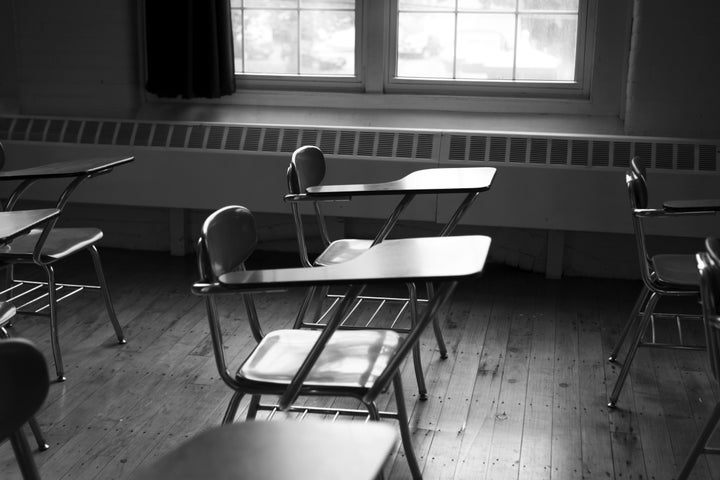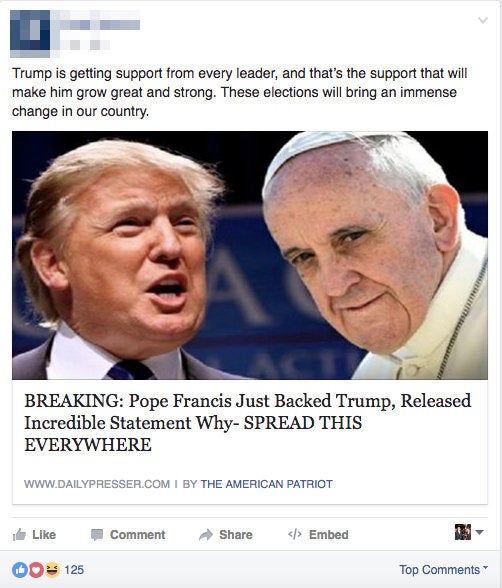
Critical literacy is essential, but not if it leads to a kind of moral relativism that tolerates all views and dismisses none in fits of false equivalence and both-siderism.
In the David Foster Wallace joke about awareness, an old fish, swimming past two younger fish, asks, “how’s the water today, boys?” and the young fish, upon swimming away, wonder to themselves “what the hell is water?”
In choosing “post-truth” as its word of the year, Oxford Dictionaries was not likely thinking about teachers and students, but the declarative dawning of a post-truth era clarifies a major challenge for progressive-minded teachers trying to help young fish figure out what the hell water is. Oxford describes post-truth as “relating to or denoting circumstances in which objective facts are less influential in shaping public opinion than appeals to emotion and personal belief.” While the neologism “post-truth” is relatively new, the term fits into a broader context of unease about the ways the modern world, especially its attendant over-reliance on social media, affects one’s ability to acquire knowledge and share concepts of truth and values.
Today’s Knowledge Landscape
One concern is that the process of acquiring knowledge has become faster, more superficial and more social. Indeed, an increasing percentage of Americans get their news through social media. Middle and high school students, so-called digital natives, are even more likely to consume media and integrate new information they find on social media. This becomes quite troubling when you consider research on the effects of social media use on teens and the generally understood neuroscience of the teenage brain. Most teachers remember card catalogues and reference books, but for our students, this is the only form of knowledge acquisition they know. Although they aren’t naïve enough to believe that if it’s online, it must be true, they most certainly believe that if it’s true, it must be online, and it’s probably been liked by lots of their friends already. Knowledge has become populist. Additionally, there is just so much content available that it can be paralyzing for young citizens to even consider trying to be informed. Media, libraries, and databases used to serve as gatekeeping filters for students, but the internet and social media perpetually aggregate more content without much regard for truth and value. Young knowledge seekers are propelled forward and onward, compelled to keep clicking, to watch the next video, to like and share.
“Although they aren’t naïve enough to believe that if it’s online, it must be true, they most certainly believe that if it’s true, it must be online, and it’s probably been liked by lots of their friends already.”
A second concern is supported by two new unsurprising but arresting studies, one from Sam Wineburg at Stanford and another from Joseph Kahne of UC Riverside and Benjamin Bowyer of Santa Clara University. Wineburg’s research shows that today’s students are dismayingly unskilled at detecting bias, identifying fake news, and evaluating truth claims. Similarly, Kahne and Bowyer show that high school students are especially susceptible to “directional motivated reasoning,” which means they prefer “to seek out evidence that aligns with their preexisting views, to work to dismiss or find counter-arguments for perspectives that contradict their beliefs, and to evaluate arguments that align with their views as stronger and more accurate than opposing arguments.” Notably, the authors saw these patterns of thought in students from across the political spectrum; they seem to be exacerbated by social media news consumption.
Millennials are coming of age in a time of deepening polarization, poisonous rhetoric, and increasing partisan rigidity. Democratic norms are being degraded before our eyes and bigotry has gone mainstream. Conor Williams, writing at The 74 Million, worries that students will struggle to develop the “habits of heart” necessary for democracy to function and may even come “to fear democratic elections.” Moreover, the constant, unyielding interrogation of the media and other societal institutions, especially online, has caused them to become even more unsure about whom or what to believe.
A teenage psyche is ill-equipped to deal with such instability, which helps explain why this is one kind of response teens have as they wade into serious issues. It’s disappointing yet unsurprising that only about half of voters under 30 actually voted. Such observations portend a dismal future for civil engagement, public debate, and civic virtue.
The post-truth era demands that teachers reevaluate how we teach media literacy, but it also clarifies the work we must do to reinvigorate our approaches to inspiring students to become patient, active, moral thinkers. John Dewey reminds us that democracy is always in the process of emerging, that “it has to be enacted anew in every generation, in every year and day, in the living relations of person to person in all social forms and institutions.” So, how shall we teach now?
Critical Literacy and Objectivity
A renewed focus on media literacy is essential to addressing post-truth ennui. A matrix of approaches, often grouped under the heading critical literacy, has been used by many progressive educators to teach students how to think. Descended from Marxist critical pedagogy, a critical literacy approach encourages students to interrogate texts for bias, uncover connections to systems of power and privilege, and identify and question missing voices and narratives. It means resisting passive acceptance of facts and authority as a source of truth. And yet, given the picture I’ve painted of our students’ knowledge landscape, I think the current moment calls for a more mature form of critical thinking. Indeed, skepticism about the sources of knowledge does not mean there is no knowledge, no commonly held set of facts or assumptions; rather, it means we have to be rigorous and objective in our scrutiny of that knowledge. We have to model for students that facts exist and help them develop their own thinking based on facts, evidence, and logic.
I have argued that neutrality in the classroom is both impossible and undesirable. Objectivity, though, is not the idea that we can assess truth claims from some misbegotten “view from nowhere” but the idea that we can assess them from a “common view,” a shared epistemic grounding that cuts across ideology and politics where reasons can be exchanged and debated. In other words, critical literacy is essential, but not if it leads to a kind of moral relativism that tolerates all views and dismisses none in fits of false equivalence and both-siderism. Moreover, if a critical literacy approach encourages students to see all media as inherently biased (mostly true) and therefore unreliable (false), we will have robbed students of the ability to pursue an understanding of truth. More essential is the development of a mature critical literacy that allows students to understand and interrogate both their own views and those held by people they disagree with and decide what to think for themselves. Again, critical skepticism doesn’t mean operating as if there’s no truth.
Knowledge Acquisition
We must help students learn to embrace the tremendous complexity and difficulty of acquiring knowledge. In looking at the ways the internet changes our way of knowing, philosopher Michael Patrick Lynch has argued that our modern form of knowing “can encourage in us the thought that all knowing is downloading — that all knowing is passive.” Our challenge then is to teach students to be active consumers and producers of knowledge. This means spending more time in class collaborating with students to build knowledge collectively. It means assigning long, extensive research projects that require students to acquire, evaluate, and reflect on their sources of information. Study historiography, not just history, so that students understand that history is reductive, selective, and always adds an interpretive layer over “what actually happened.” Share more about your own knowledge journeys; let students see the process by which you design curriculum or how your own viewpoints on an issue are evolving. Model for them a mature, reflective approach to developing ideas.
Indeed, in the concern about downloading as knowledge acquisition, it’s not hard to hear an echoing of widespread concerns about Americans’ ripeness for authoritarian propaganda. Our students are learning to know in an environment that privileges superficial, easy explanations, rapid-fire opinion formation, and confirmation bias-driven groupthink. Truly, what teacher hasn’t had students say, “can you just tell me the answer?” when our hope is that they will grapple and struggle with a complex problem? As CNN’s Brian Stetler put it, we need citizens who will “refuse to be confused” to keep society advancing. And we need to view education as developing the tools students need to unconfuse themselves.
Carol Dweck’s “growth mindset” concept has been the subject of a wealth of education writing. She suggests that students need to be taught in such a way that they can embrace a vision of themselves as works in progress. In Kahne and Bowyer’s research on the prevalence of motivated reasoning, they identified students’ deeply held assumptions about the world as an obstacle to expanding their thinking and developing better opinions. Dweck’s research shows students’ self-concept serves as a similar roadblock, preventing them from being open to their own self-improvement and growth. I’d add that students’ concepts of knowledge can operate as a similar impediment. The view that knowledge acquisition should be fast, that it should fit into an already existing worldview, and that all sources are helplessly biased serves as a major obstacle to developing mature critical thinking skills. Teachers need to operate with a theory of knowledge that is open-ended, embraces complexity, and accelerates the developmental progress of their students.
Without telling students what to think, we can teach them how to think. We can teach them to value evidence and facts by showing them how to acquire and understand them. We need students to see themselves as self-actualized agents, not docile consumers. We can simultaneously teach them about bias, spin, and propaganda while also helping them discover what’s true. And we can assert that far from being self-evident, most truth actually needs to be worked at, reflected on, and constantly scrutinized.
The Moral Imperative
Educators are faced with a moral imperative to help students learn to think and to reason, to use evidence, facts, and logic, in spite of prevailing trends. Throughout the election, teachers were rightly concerned about balancing their various responsibilities: to the truth, to democracy, to resisting bigotry, and to respecting difference. In the post-truth era, this challenge becomes even greater. There is a fundamental tension between promoting progressive ideas of inclusion and tolerance and a top-down, hierarchical approach that would seem to be dictating what students think. In the face of bigotry, however, neutrality won’t work. (Nor, however, will brainwashing, oversimplifying, or blindly labeling people. Tone-deaf pleas for civility without reflection and papering over differences, similarly, will ultimately fail.)
In The Political Classroom, Diane Hess and Paula McAvoy identify “how should we live together?” as the essential question of political education. They root this through-line in the idea that “by teaching students to weigh evidence, consider competing views, from an opinion, articulate that opinion, and respond to those who disagree,” we are able to sustain “the principles of deliberative democracy.” In a time of such extreme polarization, this question needs to be at the center of our work as pedagogues. It means teaching collaboration, discussion, empathy, and active listening within a moral context that helps students grapple with profound questions of right and wrong. According to Hess and McAvoy, the classroom is a unique democratic space because, in spite of concerns about partisanship, “the political classroom is undergirded by values that promote a particular view of democratic life and so cannot be considered neutral.” Among these values is the importance of truth and integrity, empathy, and morality.
As Jacob T. Levy puts it in reflecting on the media in the post-truth era, “insisting on the difference between truth and lies is itself a part of the defense of freedom.” It’s also part of our moral responsibility as teachers, regardless of partisanship. The pursuit of truth is not partisan. Teaching students what is morally right in concert with what is factually right is our task now.
Onward
Much of what I’ve offered here is standard aspirational progressive teacher daydreaming. And I’m sympathetic, too, to those who would resist laying yet another responsibility — saving American democracy — at the feet of our country’s teachers; I know too there’s a lot of “okay, well how?” missing here.
And yet, the dawn of this post-truth era is for me a clarion call to reevaluate and reassert the values of progressive, liberal arts teaching. In the post-truth era, defending truth — and teaching students to seek it — will not be easy, but it’s a worthy fight. We may never be able to recover what we’ve lost.
This article originally appeared on Medium here.
Follow the author on Twitter @jonnyskoal.

